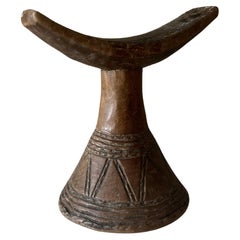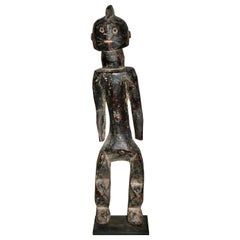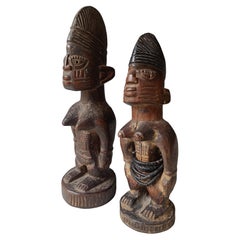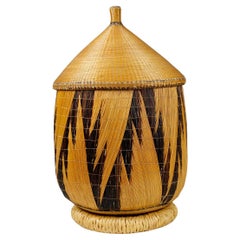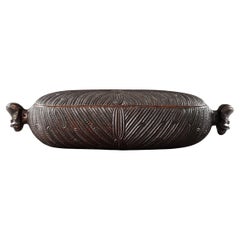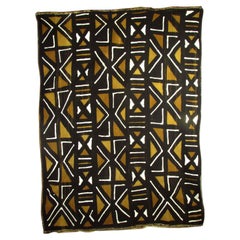Tribal Art
to
199
744
526
1,388
21
8
74
12
10
10
1
1
1
45
217
1,126
29
447
436
78
8
4
20
28
19
33
33
22
18
4
689
287
208
157
96
765
628
366
195
150
1,417
1,411
1,416
55
25
12
9
8
Tribal Art For Sale
Ashanti tribal headrest
Located in London, GB
A good example of an African Ashanti tribal headrest. Ghana. Early to mid-twentieth century.
Category
Mid-20th Century Ghanaian Tribal Tribal Art
Materials
Wood
Mumuye Figure African Sculpture
Located in Sharon, CT
Atypical form with a rich high patina. Professional mounted. Provenance: Weinberg Modern.
Category
Mid-20th Century Nigerian Primitive Tribal Art
Materials
Wood
Fine Yoruba Ibeji Female Pair African Tribal Art
Located in London, GB
Good of female Yoruba Ibeji Figures
Finely carved in dense wood with linear decoration to the body
Nigeria Period Early 20th century
Size: 27 and 25 cm Condition: Good
Fine...
Category
Early 20th Century Nigerian Tribal Art
Materials
Hardwood
Large Tutsi Prestige Basket
Located in London, GB
The distinctive sculptural form of this large Tutsi fibre basket from Rwanda - woven with the same double-layer 'igihisi' structure used to create Tutsi wall screens - is an expressi...
Category
Mid-20th Century Rwandan Tribal Tribal Art
Materials
Natural Fiber
A Finely Carved Polynesian Maori Feather ‘Treasure Box’ and Cover
Located in London, GB
A Finely Carved Polynesian Maori Feather ‘Treasure Box’ and Cover
With superb colour and patina
Wood, haliotis (abalone) shell
New Zealand
Early ...
Category
Early 19th Century New Zealand Antique Tribal Art
Materials
Wood
Mud Cloth 'Bogolanfini', Mali, Bamana People, Mid-20th Century
Located in Ottawa, Ontario
A mud cloth (Bogolanfini),
Mali, Bamana People
mid-20th century.
Hand woven 'discharge dyed' cotton
Approximately 71 x 52 in. (180cm. x 132cm.)
A dazzling geometric pattern...
Category
Mid-20th Century Malian Tribal Tribal Art
Materials
Fabric
Decorative hand-woven bag/box from Panama, Sac-Bolso by Ethic&Tropic
By Ethic&Tropic
Located in Warsaw, PL
Decorative hand-woven bag from Panama, Sac-Bolso by Ethic&Tropic
Extraordinary art and decorative items, these masks come from the shamanic beliefs and rituals of indigenous Embera ...
Category
21st Century and Contemporary Panamanian Primitive Tribal Art
Materials
Cane
Ikat Textile from Sumba Island Stunning Tribal Motifs, Indonesia
Located in Jimbaran, Bali
This exquisite ikat textile from Sumba Island, Indonesia, is a handwoven treasure that speaks to centuries of tradition, artistry, and cultural...
Category
1950s Indonesian Other Vintage Tribal Art
Materials
Yarn
Baule Standing Female Figure With Scarifications Hands Ivory Coast Africa
Located in Point Richmond, CA
Baule Standing Female Figure with finely carved raised scarifications, hands on side of stomach with long figures. From Ivory Coast, Africa
It is in good condition with wear, polis...
Category
Mid-20th Century Ivorian Tribal Tribal Art
Materials
Wood
Bembe Bearded Male Figure Bust with Beard Hands on Stomach Staff Top DRC Africa
Located in Point Richmond, CA
Striking Bembe bearded male bust figure with hands on sides of projecting stomach and finely carved beard. Stacking square hair style on top of head and projecting element hair on b...
Category
Mid-20th Century Nigerian Tribal Tribal Art
Materials
Wood
$1,560 Sale Price
20% Off
African Hand Crafted Zebra Hide Zulu Shield with Leather Lashing
Located in Los Angeles, CA
An original Zulu Shield made of Zebra Hide and lashed with woven leather. The inside back is made of wood, and handle portion was cured, covered and paint...
Category
20th Century African Folk Art Tribal Art
Materials
Zebra Hide, Wood, Paint
A Polynesian war-club or 'Gata waka'
Located in Amsterdam, NL
Fiji, probably early 20th century
Polynesian culture is traditionally a culture of power and prestige, and there was a fine line between battle and ceremony. Warrior people par exce...
Category
Early 20th Century Fijian Tribal Art
Materials
Hardwood
Antique Pyramidal Hmong Hill Tribe Silver Hairpin – Asian art antiques
Located in London, GB
Antique Pyramidal Hmong Hill Tribe Silver Hairpin – Asian art antiques
This striking large pyramidal antique silver hairpin was handcrafted by the Hmong people of northern Laos, dat...
Category
1960s Laotian Vintage Tribal Art
Materials
Silver
Antique Indian Hindu Silver Amulet necklace Ritual wearable collectible Asian
Located in London, GB
Antique Indian Hindu Silver Amulet necklace
Period 19th century
High grade silver
Pendant Length 8 x 6 cm weight 60 grams
Condition: Fine.
Restrung on cotton.
Category
Early 20th Century Indian Tribal Art
Materials
Silver
Late 19th-Early 20th Century Hand-Forged Iron Currency, Southern Chad, Africa
Located in Point Richmond, CA
Late 19th-early 20th century iron currency, kurr, Sara-Madjingaye peoples, Southern Chad.
These rare currencies have a wonderfully minimalist anthropomorphic form, but were inspired...
Category
Early 20th Century Chadian Tribal Tribal Art
Materials
Iron
Salampasu Mask
Located in Sharon, CT
In 'Congo Masks, Masterpieces from Central Africa' editor Marc Leo Felix, a photograph on page 146 depicts a group of Salampasu Masks being collected in...
Category
Early 20th Century African Tribal Tribal Art
Materials
Iron
$5,200 Sale Price
20% Off
Antique Tribal Kachin Woman’s Jacket with Shells, Myanmar (Burma)
Located in Point Richmond, CA
Antique Tribal Kachin Woman’s Jacket with Shells, Myanmar (Burma)
A small, intricately woven woman’s jacket from the Kachin (Maru) tribal group located in the far northeast of Myanm...
Category
Mid-20th Century Burmese Tribal Tribal Art
Materials
Cotton
Late 19th-Early 20th Century Tribal Mask, West Nepal
Located in Point Richmond, CA
Late 19th-early 20th century Tribal mask, West Nepal
A mask from West Nepal with a sharp straight nose, squinting eyes and a square mouth showing upper and lower teeth. There are re...
Category
Late 19th Century Nepalese Tribal Antique Tribal Art
Materials
Wood
African mask Toussiana bird Burkina Faso Mid XXem
Located in Paris, FR
Toussiana Plank Bird from Burkina Faso Mid XXem
Provenance: private Swedish collection , auction
The TOUSSIAN live in the Southwest of Burkina Faso. The mask presented here is a Loni...
Category
Mid-20th Century Burkinabe Tribal Tribal Art
Materials
Wood
African Tribal Statue Osseyba or Reliquary Figure Kota Mohongwe Peoples Art
Located in Miami, FL
A fantastically hand-crafted piece by the Kota (or Bakota) tribe who are located in the northeastern region of Gabon. This figure, which is a Mahongwe reliquary figure as exhibited with its truncated almond-shaped face, is made of wound copper, hammered brass and wood. Reliquary figures were used as guardians to protect the revered bones of venerated family ancestors and leaders and ward off unwanted spirits. These figures are meant to embody intense powers and were also commonly used in communal rites and ritual performances.
This particular piece came from an American collector who traveled the African continent and collected African artifacts for over 50 years. This piece has a beautiful, organically aged patina acquired naturally over time and use. It is mounted on a custom wooden display stand. We believe it dates back to the early to mid-1900s but could be older. We are listing as 20th century because we did not have it appraised.
This African Tribal Statue Osseyba or Reliquary Figure Kota (Bakota) Mohongwe Peoples decorative art would clearly stand out as part of a collection or by itself in any setting. Truly unique, eye-catching and engaging.
Dimensions on stand: 25 3/4" High, 7" Wide, 5 1/2" Deep
Kota Reliquary...
Category
Early 20th Century Gabonese Tribal Tribal Art
Materials
Brass, Copper
$2,560 Sale Price
20% Off
Nepal Mahakala Wood Dance Mask with Open Eyes Fierce Mouth Teeth
Located in Point Richmond, CA
Carved wood smaller dance mask from Nepal with powerful expression, open eyes and open mouth with carved teeth and fangs, representing the Buddhist Mahakala, the demon chaser. The to...
Category
Early 20th Century Nepalese Tribal Tribal Art
Materials
Wood
Tuareg African Pewter Tea Pot from Mauritania
Located in North Hollywood, CA
Vintage African Tuareg teapot Mauritania
Mid-20th century Tuareg teapot from Mauritania, Africa, Western Sahara.
Handcrafted of pewter, copper and brass ...
Category
Mid-20th Century Mauritanian Folk Art Tribal Art
Materials
Brass, Copper, Pewter
Antique Tetela Textile, DR Congo
Located in Point Richmond, CA
Congolese Textile
Tetela
DR Congo
19th century
Measures: 68 x 41 inches (172 x 104 cm)
Provenance: Ambre-Congo gallery, Brussels
$5,000.
A very rare ...
Category
1880s Congolese Tribal Antique Tribal Art
Materials
Natural Fiber
Rare Gold Ashanti Royal Bracelet from Jacaranda Tribal
Located in New York, NY
This magnificent gold bracelet was made for Ashanti royalty.
The Ashanti Kingdom's wealth was significantly based on gold-mining and trading in gold, as well as agriculture. The ki...
Category
Early 20th Century Ghanaian Tribal Art
Materials
Gold
Chinese Folk Wood Dance Mask with Open Eyes Red Lips Traces of Paint China
Located in Point Richmond, CA
Carved hard wood dance mask from China with powerful expression, open eyes. Traces of many layers of paint, including red green black and white pigments.
Ex- private collection in C...
Category
Early 20th Century Chinese Tribal Tribal Art
Materials
Wood
Carved Wood Aboriginal Shield, Western Australia
Located in Atlanta, GA
A tall and narrow parrying shield from the Aboriginal people living in the Western Australia. The piece was carved out of a single block of hard wood t...
Category
Early 20th Century Australian Tribal Tribal Art
Materials
Wood
Woven Mat, Kuba People
Located in Point Richmond, CA
A Kuba mat from the Kasai region of the D.R.Congo
These were used on the ground, there are photos showing the Kuba King seated on similar ones.
Raffia cord is wrapped around the thic...
Category
Mid-20th Century Congolese Tribal Tribal Art
Materials
Raffia, Palmwood
$1,250
Mid-20th Century Tribal Beaded Cache-Sex Modesty Apron, Cameroon
Located in Point Richmond, CA
Mid-20th century tribal beaded cache-sex modesty apron (Pikuran),
Mandara Mountains, Cameroon
These colorful cache-sex were worn for celebrations, rituals...
Category
Early 20th Century Cameroonian Tribal Tribal Art
Materials
Shell, Beads
$450 Sale Price
50% Off
Old Copper Coins of Congo, Africa / Rare Objects / Folk Art/20th century
Located in Sammu-shi, Chiba
This is an old African coin.
Before paper money and money were in circulation, bartering was taking place in Africa.
Various goods such as textiles, fea...
Category
20th Century Congolese Other Tribal Art
Materials
Copper
Bronze Currency Bracelet/Manilla, Dogon People, Burkina Faso, 19th c. - No 3
Located in Aramits, Nouvelle-Aquitaine
19th-century bronze currency bracelet / Manilla in horseshoe form with fixed opening. Intricate graphical design with a lattice pattern. This type of bracelet was worn or used by the...
Category
Mid-19th Century Burkinabe Tribal Antique Tribal Art
Materials
Bronze
Wooden Mortar and Pestle with Nail Studs
Located in Los Angeles, CA
Wooden mortar and pestal with nail studs - an attractive piece, used as a prop in the television show MAD MEN. A lovely decorative piece or use it to crus...
Category
20th Century Mid-Century Modern Tribal Art
Materials
Wood
Antique 19th C Hindu Shiva Brass Votive Head Indian Ritual Art Sculpture
Located in London, GB
Antique Indian Hindu Shiva Brass Votive Head – 19th Century
Beautiful 19th-century brass votive head of Lord Shiva, finely cast with detailed moustache and turban. This larger form ...
Category
18th Century Indian Antique Tribal Art
Materials
Brass, Bronze
Antique Akha Hill Tribe Silver Cuff Bracelet, 517grams
Located in Jimbaran, Bali
An exceptionally large Akha Tribe woven silver bracelet with spiral design. This Tribal bracelet encompasses tradition Hill tribe silversmithing techniques ...
Category
Early 20th Century Thai Tribal Tribal Art
Materials
Silver
South African Zulu Two Handled Carved Wood Meat Tray
Located in Ottawa, Ontario
A South African two handled carved wood meat tray
Zulu, 20th century
Measures: Approximate 3 1/4" in. high x 10 1/2" in. long x 8 1/2" in. wide
(8.2 x...
Category
Mid-20th Century South African Tribal Tribal Art
Materials
Wood
Striking Makonde Animal Helmet Mask, Dog or Hyena, Tanzania, Early 20th C.
Located in Point Richmond, CA
Striking Makonde animal helmet mask, dog or hyena, Tanzania. Early 20th century with dark patina from traditional tribal use, wear inside from being used. Finely carved features, wit...
Category
Early 20th Century Tanzanian Tribal Tribal Art
Materials
Wood
$1,400 Sale Price
20% Off
Heavy Vintage Deity Head, South American, Carved Crystal, Gilt Metal, Artefact
Located in Hele, Devon, GB
This is a heavy vintage deity head. A South American, carved crystal and gilt metal decorative artefact, dating to the mid 20th century, circa 1950
Highly distinctive and fascinati...
Category
Mid-20th Century South American Tribal Tribal Art
Materials
Metal
Antique Decorative Moroccan Arabian Jambiya
Located in North Hollywood, CA
Antique decorative Moroccan Arabian khoumaya or Jambiya, which is the name in Arabic Ornate with brass and silvered steel hammered element and wood handle. The decorative dagger is v...
Category
Mid-20th Century Moroccan Islamic Tribal Art
Materials
Metal, Brass
Rare Silver Balangandãs - 20th Century Brazilian Native Hanging Amulet
Located in Rio De Janeiro, BR
Mid 20th century brazilian silver hanging amulet from native culture in Brazil. Known as "Penca de Balangandãs" was used in the ancient times as an amul...
Category
Mid-20th Century Brazilian Other Tribal Art
Materials
Sterling Silver
Genuine wooden carved spoon from the Zulu tribe, South Africa, early 1900
By Zulu's
Located in Bilzen, BE
Zulu people are a native people of Southern Africa of the Nguni. The Zulu people are the largest ethnic group and nation in South Africa, living mainly in the province of KwaZulu-Nat...
Category
Early 20th Century Tribal Tribal Art
Materials
Wood
Set of Two Decorative Vintage Mexican Painted Dance Masks Lizard & a Mermaid
Located in Point Richmond, CA
Group of two polychrome painted wood mid-20th century Mexican dance masks. Each with a face one with a lizard on top and the other with a mermaid....
Category
Mid-20th Century Mexican Tribal Tribal Art
Materials
Organic Material, Wood
$760 Sale Price
36% Off
20th Century Fante Asafo Flag, Ghana
Located in New York, NY
A large and graphically stunning Fante asafo flag.
Fante flags represent the merger of two cultural traditions, the Akan tradition of combining pro...
Category
Mid-20th Century Ghanaian Tribal Art
Materials
Fabric
African Tribal Yoruba, Nigeria Rider Figure Offering Bowl Early 20th Century
Located in Point Richmond, CA
Early Yoruba offering bowl in the from of a male figure with a beard riding on horse back surrounded by four small attendants, finely carved with nice patina from native use. Probabl...
Category
Early 20th Century Nigerian Tribal Tribal Art
Materials
Wool
$1,400 Sale Price
28% Off
Tribal Xylophone, Africa, Early 20th Century
Located in Roma, IT
Tribal xylophone is an original design item realized in the early 20th Century.
A rare xylophone entirely realized in wood. Working.
A unique decorative object and at the same ...
Category
Early 20th Century African Tribal Art
Materials
Wood
$11,623 Sale Price
30% Off
Solid Brass/Nickel Alloy Cuff Bracelet, Nupe People, Nigeria, 19th/20th Century
By Nupe
Located in Aramits, Nouvelle-Aquitaine
Late 19th or early 20th-century brass or copper alloy with higher nickel content. Bracelet in horseshoe form with fixed opening. Pierced design with rectangular shapes and carved swi...
Category
Early 20th Century Nigerian Tribal Tribal Art
Materials
Brass, Nickel
Old Cedar Wood Sweet Refined Large Egyptian Mummy Mask
Located in Point Richmond, CA
Elegant old cedar wood sweet large Egyptian mummy mask, 13 Inches high. Soft weathered surface and great expression. Areas of chips, erosion and li...
Category
15th Century and Earlier Egyptian Tribal Antique Tribal Art
Materials
Organic Material, Wood
Himalayan Tribal Tharu Guardian figures Nepal Himalayan Art Antiques
Located in London, GB
A outstanding pair of ancestor figures from the Tharu people of Southern Nepal.
The standing guardian figures, the faces with serene enigmatic expression,
Ancient weathered patina...
Category
19th Century Tibetan Antique Tribal Art
Materials
Wood
Bronze Head of an Oba, Yoruba People, 1950s
Located in Aramits, Nouvelle-Aquitaine
A Benin bronze of an Oba. Oba means ruler in the Yoruba language.
Wearing a lattice-pattern cap with strands of beads suspended around the head.
The neck is bound with a lattice-patt...
Category
1950s Beninese Tribal Vintage Tribal Art
Materials
Bronze
Antique Moroccan Leather Bag Belonging to a Family of Water Carriers
Located in Munich, DE
This magnificent leather bag is covered entirely with old coins on the front,
as was often the case with these kind of bags. The strap might have b...
Category
1920s Folk Art Vintage Tribal Art
Materials
Leather
Senufo Bed from Ivory Coast
Located in Sagaponack, NY
A West African Senufo bed hand carved from a single tree having four tapered legs with a raised headrest and decorative scallop detail.
Category
20th Century Ivorian Tribal Tribal Art
Materials
Wood
$11,000
18th Century Ngelima Bronze Currency Piece on Custom Steel Mount
Located in Chicago, IL
This rare 18th-century Ngelima bronze currency manilla is a stunning artifact, weighing an impressive 20 pounds of solid bronze. Adorned with intricate incised line drawings at its e...
Category
18th Century Congolese Tribal Antique Tribal Art
Materials
Bronze
$2,625 Sale Price
25% Off
Early Papua Korwar Ancestor Figure, Early 19th Century, Deep Black-Brown Patina
Located in Amsterdam, NL
An extremely rare Papua wood sculpture of a Korwar
Papua New Guinea, Cendrawasih Bay, Wandammen, early 19th century
Measures: Height 24 x Diameter 18 cm
Finely carved in th...
Category
Early 19th Century Indonesian Tribal Antique Tribal Art
Materials
Wood
African Ashanti Kente Cloth
Located in Dallas, TX
African Ashanti Kente Cloth,
hand loomed textile, ceremonial regalia worn by the tribe early to mid 20th Century
Category
20th Century African Tribal Art
20th Century Bark Cloth Painting, Mbuti 'Efe' People, D.R. Congo
Located in Point Richmond, CA
20th Century bark cloth painting, Mbuti (Efe) people, Ituri Forest, D. R. Congo
A painted barkcloth from the Efe people in the Ituri forest of no...
Category
1970s Congolese Tribal Vintage Tribal Art
Materials
Natural Fiber
Set of Three Rare Fang Wood Spoons, Gabon, Africa old collection provenance
Located in Point Richmond, CA
Set of three rare Fang carved wood spoons, from Gabon, Africa. Each with unique shape, wear and encrustings from traditional tribal use.
They are in good condition, appropriate for...
Category
Mid-20th Century Malian Tribal Tribal Art
Materials
Wood
Mid Century African Women Wood Sculpture
Located in Delray Beach, FL
Exceptional African wood carving ,mounted on custom-made steel base of women graciously looking forward, beautiful facial expression, and very ni...
Category
1960s Vintage Tribal Art
Materials
Steel
$1,100 Sale Price
34% Off
Vintage Peruvian Folk Art Framed Negreria Dance Cape
Located in Forney, TX
A scarce framed fragment of "Negreria" dance cape, circa 1940s, Huayucachi, Junin, Peru.
Dating to the mid-20th century, the rare large size South ...
Category
Mid-20th Century Peruvian Folk Art Tribal Art
Materials
Textile, Cotton, Sequins
Two Tribal Bronze Konga Anklet Leg Band
Located in North Hollywood, CA
An early 20th century antique African tribal leg band (ankle bracelet),
These leg bands were both currency and status symbols for the Mongo tribe of northwest Congo.
They were ma...
Category
Early 20th Century Congolese Folk Art Tribal Art
Materials
Bronze
$1,850 / set
Kuba Dye-Resist Tcaka Textile
Located in Chicago, IL
Visually dynamic and highly textured, this raffia textile expresses the irregular, geometric patterns typical of Kuba textile art. Created by an artisan of the Kuba people of the Dem...
Category
20th Century Congolese Tribal Tribal Art
Materials
Raffia
Pre Columbian Rare Lambayeque Wood Figure
Located in London, GB
Pre columbian Lamabayeque wood figure Peru Circa 750 to 1375 AD
A rare standing figure of a deity with triangular tear drop shaped eyes holding a child,
Carved in very dense heavy hard wood
Measures: Height 14 inches, 36 cm weight, 1.5 kg approx
Ex collection of a Oxford Academic, reputed to have came from Pit rivers...
Category
15th Century and Earlier Peruvian Antique Tribal Art
Materials
Wood
20th Century Red Mola Quilt, Kuna People, San Blas Islands, Panama
Located in Point Richmond, CA
20th century Mola quilt, Kuna People, San Blas Islands, Panama
This large quilt is composed of thirty-six molas, including some depicting various animals and sea creatures, Jesus Ch...
Category
1970s Panamanian Tribal Vintage Tribal Art
Materials
Cotton
